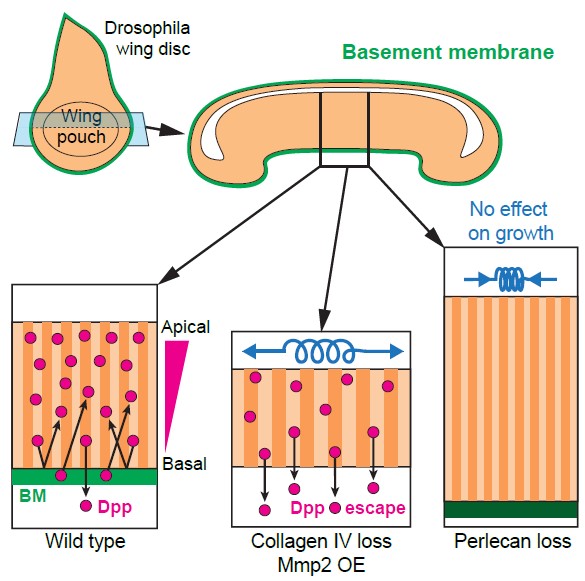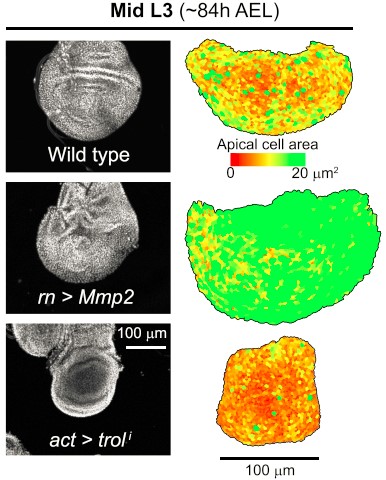|
Jose C. Pastor-Pareja’s group reports in Developmental Cell their latest findings on the function of basement membranes in tissue growth control. The work investigated the developmental role of the basement membrane (BM), a conserved polymer of matrix proteins present in tissues of all animals. Specifically, Ma et al. decided to explore the influence of the BM and BM-exerted mechanical tension on wing development in Drosophila fruit flies, a model biologists have been using for the last 50 years to research patterning and growth control mechanisms. In their experiments, Ma et al. discovered a positive role of the BM on growth, but no basis for the widely held view that increased cell compression slows wing growth and determines its final size.
Mengqi Ma and other members of the Tissue Morphogenesis laboratory at Tsinghua School of Life Sciences found that BM elimination attenuated signaling by growth-promoting BMP/TGFβ ligand Dpp, indicating that the BM reduces Dpp escape from the tissue. Her results uncover a role of BMs in preserving a growth-promoting tissue environment. They also open new avenues in the study of BMP/TGFβ gradient formation, with important implications for the engineering of tissues for medical purposes.
During the last decade, models for mechanoregulation of wing growth have gained considerable attention, as alternative models based on morphogen concentration gradients were becoming increasingly difficult to reconcile with the experimental evidence. In this study, Ma et al. manipulated BM composition to cause dramatic changes in tissue tension. They found that increased tissue compression when perlecan was knocked down did not affect adult wing size. BM elimination, decreasing compression, reduced wing size but did not visibly affect Hippo signaling, widely postulated to be a mediator of growth mechanoregulation. BM elimination, in contrast, attenuated signaling by BMP/TGFβ ligand Dpp, which was not efficiently retained within the tissue and escaped to the body cavity. These results challenge mechanoregulation of wing growth, while uncovering a function of BMs in the retention of growth-promoting ligand Dpp within tissues.
 
Left: The basement membrane (BM) contributes to tissue growth by enhancing tissular retention of BMP/TGFβ ligand Dpp. Right: Changes in tissue compression upon BM manipulation.
The article, entitled “Basement membrane manipulation in Drosophila wing disc affects Dpp retention but not growth mechanoregulation”, was published on July 10th, 2017. Work reported in this article was conducted entirely in Jose C. Pastor-Pareja’s laboratory of the School of Life Sciences at Tsinghua University. Ph.D. student Mengqi Ma (female, PTN program) is the first author of the work, to which Xueya Cao (female, CLS program) and Jianli Dai (female, CLS program) also contributed. The research was funded by Natural Science Foundation of China, Tsinghua Initiative program and 1,000 Talents program.
http://www.cell.com/developmental-cell/fulltext/S1534-5807(17)30460-4
http://joselab.www.niepad.com/
|
